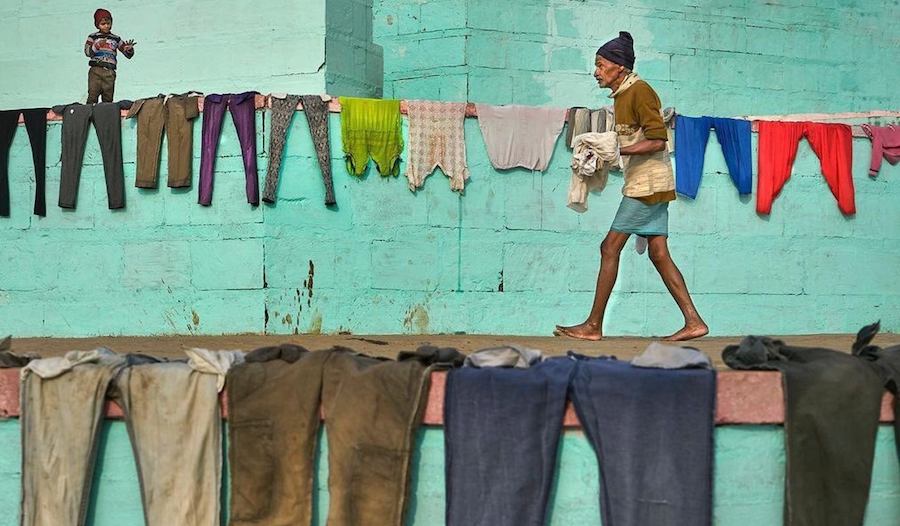
#CLOTHESLINEPOETRY
Image: Courtesy of #clotheslinepoetry
According to the Association of Home Appliance Manufacturers, there are more than 90 million clothes dryers in the United States. Yet it’s estimated that if Americans line-dried their clothing for just six months each year, it would save 3.3 percent of the country’s total residential output of carbon dioxide and reduce the average household’s carbon footprint by a 2,400 pounds a year.
Now multiply that by every country on the planet.
So, what’s putting people off? If line-drying was good enough for our grandmothers, what has changed?
 Image: Courtesy of #clotheslinepoetry
Image: Courtesy of #clotheslinepoetry
The length of time it takes to air-dry clothes obviously depends on several factors, from fabric to weather. On a warm, sunny day, air-drying outside can take as little as 45 minutes, and the ultra-violet rays of sunlight will help to bleach and disinfect your laundry. This is particularly beneficial for white items, towels, and washable nappies (diapers). Whilst it’s true that darker clothes might benefit from being hung at the shadier end of your line, consider that the weight of the water in freshly washed clothes gently stretches them back to their original shape as you hang them on the line, helping to naturally remove wrinkles and creases. And, of course, no fabric freshener or chemically perfumed drier sheet can ever compete with that inimitable fresh-from-the-line scent.
 Image: Courtesy of #clotheslinepoetry
Image: Courtesy of #clotheslinepoetry
And if you don’t live in sunnier climes, you can always air-dry indoors. This can enhance your domestic environment. When colder temperatures drive us to switch on our heating, the humidity level inside our homes drops. Lower humidity can contribute to dry nasal passages that welcome cold and flu viruses. Drying clothes on indoor racks can add humidity to a home's internal environment.
 Image: Courtesy of #clotheslinepoetry
Image: Courtesy of #clotheslinepoetry
If you’ve already experimented with indoor drying and been left with musty-smelling laundry, you simply need to perfect your technique. This smell is caused when there is excess moisture that can’t escape. Don’t leave wet laundry in the washing machine too long before hanging it out to dry, and space your laundry on the hanger, so that air can flow around your clothes. If you’re air-drying indoors on a warmer day, consider opening a window to encourage the moisture to evaporate.
 Image: Courtesy of #clotheslinepoetry
Image: Courtesy of #clotheslinepoetry
One run of a tumble dryer costs £2.16 (€2.47, or $2.41) and, shockingly, in the U.S. the yearly structural costs for fire loss due to clothes dryer fires is estimated at $99 million, with an annual average of 15,600 fires, 15 deaths, and 400 injuries.
The action of a tumble dryer can stress the seams of your garments, snag buttons and zippers, and generally cause heat stress to the fibres. And if you’re not yet persuaded, consider that the average time it takes to hang a load of laundry is less than ten minutes, during which time you’ll have given yourself an opportunity to take a break from your screen, enjoy the weather, and savour the feel and smell of clean laundry. The process can be meditative, helping to reduce stress and burning roughly 68 calories. That's the equivalent of 20 olives, two clementines, or three mini candy bars.
 Image: Courtesy of #clotheslinepoetry
Image: Courtesy of #clotheslinepoetry
At SELVEDGE, we advocate ditching the dryer in favour of the washing line— better for your clothes, better for the planet, better for your wallet! So, why not head over to Instagram to browse through the 5000+ posts and reels of #clotheslinepoetry, and start appreciating what your clothes line can offer.
Our thanks to blue earth clean and the spruce for some of the data in this article.

2 comments
I agree with Andrea’s comments on the beauty of the photography. I live in an 83-unit building in the South Bronx [New York City] where clothes dryer accompanied with softening sheets are the norm. I’ll take a crunchy feeling towel fresh off a clothes line any time!
What a grand idea! What gorgeous photos! How unlikely that it would be accepted by most HOA’s in the USA!